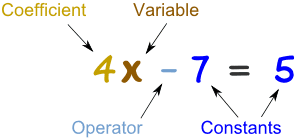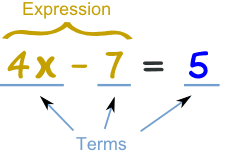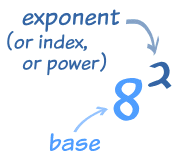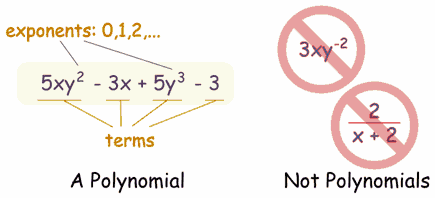Algebra - Basic Definitions
It may help you to read Introduction to Algebra first
What is an Equation
An equation says that two things are equal. It will have an equals sign "=" like this:
| x | + | 2 | = | 6 |
That equations says: what is on the left (x + 2) is equal to what is on the right (6)
So an equation is like a statement "this equals that"
Parts of an Equation
So people can talk about equations, there are names for different parts (better than saying "that thingy there"!)
Here we have an equation that says 4x-7 equals 5, and all its parts:
 | A Variable is a symbol for a number we don't know yet. It is usually a letter like x or y. A number on its own is called a Constant. A Coefficient is a number used to multiply a variable (4x means 4 times x, so 4 is a coefficient) An Operator is a symbol (such as +, ×, etc) that represents an operation (ie you want to do something with the values). |
 | A Term is either a single number or a variable, or numbers and variables multiplied together. An Expression is a group of terms (the terms are separated by + or - signs) |
So, now we can say things like "that expression has only two terms", or "the second term is a constant", or even "are you sure the coefficient is really 4?"
Exponents
 | The exponent (such as the 2 in x2) says how many times to use the value in a multiplication. Examples: 82 = 8 × 8 = 64 y3 = y × y × y y2z = y × y × z |
Exponents make it easier to write and use many multiplications
Example: y4z2 is easier than y × y × y × y × z × z, or even yyyyzz
Polynomial
Example of a Polynomial: 3x2 + x - 2
A polynomial can have constants, variables and the exponents 0,1,2,3,...
And they can be combined using addition, subtraction and multiplication, ... but not division!

Monomial, Binomial, Trinomial
There are special names for polynomials with 1, 2 or 3 terms:

Like Terms
Like Terms are terms whose variables (and their exponents such as the 2 in x2) are the same.
In other words, terms that are "like" each other. (Note: the coefficients can be different)
Example:
| (1/3)xy2 | -2xy2 | 6xy2 |
Are all like terms because the variables are all xy2
No comments:
Post a Comment